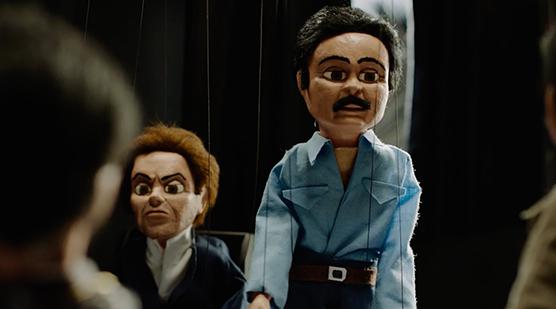El Chapo, Univision and Netflix’s co-produced series about notorious Mexican drug kingpin Joaquin “El Chapo” Guzman, is one of those pleasingly untrustworthy efforts where every character has an ulterior motive, and no one is safe from being exploited by someone else.
“You read the script and you see everybody is manipulating everybody to get their way,” said Lixaida Lorenzo, associate creative director for agency Mistress. “Within the cartel, you see El Chapo manipulating his boss to get his way. You see his boss manipulating other people. You see the government officials manipulating the DEA, who are manipulating the cartels to in order to get more power… Everybody is everybody’s puppet.”
It’s a theme that Mistress took quite literally as Lorenzo’s team built a sweeping social campaign for the show’s first season, which aired its broadcast finale in May and now comes to Netflix to live in perpetuity. From a 360-degree interactive narco tomb to show-themed Lucha Libre (Mexican wrestling) posters, the campaign included more than 200 pieces of Spanish-language content. But its tour de force was a collection of teasers that recreated cryptic scenes from upcoming episodes using traditional marionette puppets.
The launch spot above would set the tone for the season’s subsequent teasers, rising up through a ladder of key El Chapo characters-turned-marionettes, each one manipulating the figure beneath it. Finally, the camera passes El Chapo himself before stopping on the god-like hand of an actual human. Producing the spot involved combining real-world puppets and a bare-bones set with green-screen technology. Each marionette was shot individually, looking down from the same balcony, then stitched together in post with the upward camera move.
To create the marionettes, Mistress collaborated with professional puppet maker Dan Payes, whose creations – largely consisting of ventriloquist dummies – have graced shows such as Workaholics and Modern Family. The El Chapo puppets, Payes told Daily Brief, “are mostly made of wood and fabric. The heads are made of mannequin composition, an old-school doll-making material that can be cast in a mold. This allowed multiples of one character.”
It was important to be able to streamline the duplication process, Payes said, because he had to turn around a large number of handmade puppets quickly.
“The biggest challenge was making 11 marionettes in one week, especially since I have never made marionettes for a production before. A big part of it was the small-scale clothes. Luckily, my creative seamstress Tonia Bodley was able to pull through and complete them in time.”
Indeed, the El Chapo character warranted three separate puppets by himself, reflecting different stages of his life throughout the show that were reflected in corresponding teasers. In one, a younger El Chapo at the top of his game faces off with another cartel member who killed his good friend. In another, he has been arrested for his crimes and sports a different haircut. And in his final season-one teaser appearance, he has spent months in prison, in the hole, which warranted a puppet that looked decidedly less peppy.
“We wanted to make sure they looked gritty and serious and conveyed the darkness that the show has,” Lorenzo said. “We wanted you to feel the seriousness on their faces and when you’re close up you see they’re not shiny. They’re porous so they have that raw look to them.”
To operate the puppets during the shoot, Mistress brought in the skilled professionals at Bob Baker Marionette Theater in Los Angeles. The puppeteers rehearsed their movements to sync up with actual audio from the show. Sets were kept raw and minimal and dark, enhancing the feeling of an old-fashioned puppet show unfolding onscreen.
“The shoot was exactly like you shoot any story, but instead of actors they were puppets,” Lorenzo said. “Puppets are really nice to work with. They’re not divas. They take direction well.”
On the other end of the spectrum from the puppet teasers’ stark visual economy lies Mistress’ interactive take on a narco mausoleum tomb. These lavish odes to Mexico’s deceased drug lords can cost millions of pesos to build, and feature embellishments such as furniture, cooking grills and even air conditioning. Mistress’ version isn’t quite that fancy, but what it lacks in opulence it makes up for in sheer quantity of detail, packing every wall of the three-dimensional space (which was also made into a teaser in its own right) with photos, objects and other ephemera from the show. Fans who take a minute to poke around the tomb on Facebook have more than 300 elements to discover, including choice Easter eggs such as the cans of chiles El Chapo used to smuggle drugs in, and a green cooler used to store the severed head of a drug lord’s wife.
“Blood, sweat and tears,” Lorenzo said of constructing the tomb. “We built that in our in-house studio, and we built it in two days. Everything is meticulously hand-selected. This is not just, ‘oh let’s print a bunch of stuff.’ [The tomb is full of] the most important moments from the show.”
Stylistically, the puppet spots and the tomb elements couldn’t be more different. Where the marionettes are highly, almost jarringly impressionistic, the mausoleum is exhaustively specific. Yet they share common ground in that both have the raw, tactile presence of actual stuff as opposed to the gloss of digital effects.
“For this kind of show it had to real and gritty,” Lorenzo said. “CGI wouldn’t cut it.”
CREDITS
Agency: Mistress
Executive Creative Director, partner & founder: Scott Harris
Strategy, partner & founder: Christian Jacobsen
Group Brand Director: Tor Edwards
Creative Director: Lixaida Lorenzo
Design Director: Samuel Farfsing
Project Manager: Berna Dikicioglu
Front End Developer: Dave Averdick
Production Director: Dave Horowitz
Producer: Shawn Dougherty
Co-Producer: Jack Zegarski
Social Director: Iyana Sarrafieh
Social Strategist: Anna Lucy Terry
Audience Manager: Allison Ramirez
Production House: Bastard
Post House: Dedicated Content
Tags:













































__twocolumncontent.jpg)











